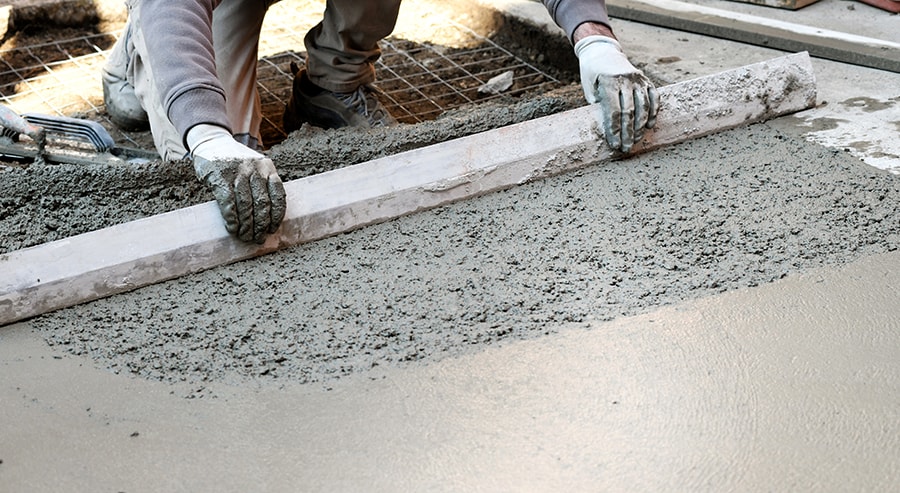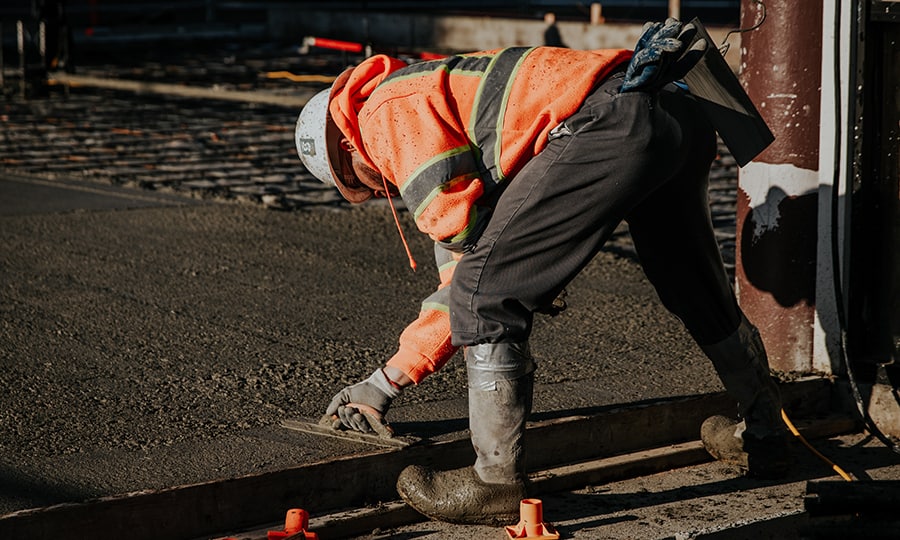What is a lean concrete mix? It’s a versatile type of concrete with a cement content of less than 10% of the total mixture.
It’s a fantastic alternative to compacted soil that’s not like the sturdy concrete you’d find in massive structures. With its low strength and self-leveling properties, it’s a breeze to remove. Plus, you can adjust the cement content and create an entirely new material!
Lean concrete mixes are incredibly flexible and perfect for all sorts of construction projects, from paving to laying foundations. I’ll show just how adaptable it can be. But first, let’s quickly dive into how concrete is made.
How is concrete made?

Concrete turns into a hardened building material when you mix these ingredients:
- Water
- Fine aggregate (natural sand particles)
- Coarse aggregate (gravel, crushed stone, and recycled concrete)
- Cement
- Optional: Admixtures – chemicals that modify the mix’s properties

Important Note: Portland cement is the most popular cement for concrete. It’s a fine gray powder made by heating limestone and clay minerals in a kiln to form clinker. After that, the clinker is ground up, and 2% to 3% gypsum is added.
When you mix water with Portland cement, a heat-releasing (exothermic) reaction called hydration occurs. This reaction leads to the hardening of your mixture.
Why include aggregate in the mix?
Believe it or not, adding stones and sand is crucial for boosting the strength of concrete. When cement bonds with the jagged edges of the stone, it forms robust bonds that significantly enhance the strength of the final product.
But wait, there’s more! Using aggregate in your concrete mix also reduces shrinkage compared to using cement alone. This makes your concrete not only stronger but more durable as well.

Important Note: Concrete aggregates can have either a smooth or rough surface. The smoother the surface, the more workable the concrete. On the flip side, rougher surfaces produce stronger concrete.
To learn more about the ingredients and the science behind concrete, check this out.
What is a lean concrete mix?
As I mentioned earlier, the key feature of a lean concrete mix is its low cement content. But there’s more – this type of concrete also uses fine aggregate. You can use recycled materials like concrete pavement, sand, or ash instead of the heavy, high-density rocks and sand typically used in other types of concrete.
The result? A budget-friendly and easy-to-make mix perfect for a wide range of construction projects.
But what’s the performance like for this type of concrete? Here are some typical test and performance specs:
- A minimum strength of 2.1 MPa or 300 psi per ASTM C 39 at 28 days after placement.
- Bleed water evaporation should not result in shrinkage of more than 10.4 millimeters per meter (1/8 inch per foot) of lean concrete fill.
- Lean concrete fill should have a unit weight of 1900 to 2300 kg/m^3 (115 to 145 lbs/ft^3). This should be measured at the concrete pouring site after a 60-minute ready-mix truck ride.
- The mix design should produce a consistency that results in flowable concrete when poured. This means there should be no need for manual labor to move the concrete into place, resulting in an easily pourable, uniform surface.
The lean concrete mixture ratio

Let me give you the scoop on the three most common types of concrete and how they compare to the unique blend found in lean concrete.
- Lean concrete mix
- Normal concrete mix
- Rich concrete mix
Water content can vary depending on the project, but that’s not our focus right now.
Lean concrete mix
Lean concrete is absolutely amazing when it comes to creating smooth surfaces for structural reinforcements like footings. It also serves as a protective barrier between a structure’s concrete foundation and the soil, keeping pesky moisture and chemicals like sulfate at bay.
But wait, there’s more! Lean concrete can fill open areas where plain ol’ dirt just won’t cut it, making it a top pick for shoring up excavations or filling over-excavations. What’s more, it’s way tougher than compacted soil and flowable enough to slip into all those tricky nooks and crannies.
Just remember, lean concrete mix isn’t the strongest contender in the concrete game.
Cement content: Less than 10%.
Mix ratios:
- Cement (1 part)
- Fine aggregate (4 parts)
- Coarse aggregate (8 parts)

Important Note: The Water/Cement (W/C) ratio for lean concrete mix is typically high to keep it workable. It generally ranges from 0.4 to 0.5, but can be as high as 1.1 in some cases.
This high W/C ratio makes pouring the concrete out of a truck and onto the job site a piece of cake.
Another bonus? Lean mixes have less shrinkage compared to other concrete mixes. Remember, as water content goes up, so does the dry shrinkage of the concrete. So, keeping that water content low is key to reducing shrinkage.
Normal concrete mix
This is your run-of-the-mill concrete. It’s perfect for everyday projects that don’t require high tensile strength.
Normal concrete is the go-to for things like roads, residential buildings, and multi-story structures. Just don’t expect to see it holding up megastructures or skyscrapers.
Cement content: 10% to 15%
Mix ratios:
- Cement (1 part )
- Fine aggregate (2 parts)
- Coarse aggregate (4 parts)
Rich concrete mix
This type of concrete is the go-to choice for mammoth construction projects where structures face constant heavy loads. Think towering skyscrapers, massive dams, and sturdy bridges – they all rely on this robust concrete variant to endure the strain.
For example, it’s used in mega structures such as skyscrapers, dams, and bridges.
Cement content: Greater than 15%
Mix ratios:
- Cement (1 part )
- Fine aggregate (1.5 parts)
- Coarse aggregate (3 parts)
Admixtures for lean concrete mixes
Even when you’re working with simple concrete mixes, sometimes you gotta add a little something extra to make it work just right. These handy-dandy additives can be customized to fit whatever project you’re working on.
Let’s check out the top five most common additives to make your mix even better!
#1 Air entraining agents: These help make the concrete easier to work with, which is super important when you’re dealing with freezing temperatures, thawing, sulfates, or seawater.
#2 Accelerators: These help the concrete harden faster in cold weather. You can use stuff like calcium chloride or non-calcium chloride, but stay away from calcium chloride boosters if you’re working with seawater, reinforced concrete, or if the concrete is touching aluminum or other metals that don’t contain iron.
#3 Pozzolans: This stuff can replace or boost the cement in your concrete mix, letting you use less cement while still getting the strength you need. The only downside is that it might take a bit longer to set compared to just using Portland Cement.
#4 Retarders: This slows down the hardening of concrete, which comes in handy when you’re working in super hot places.
#5 Water reducers: These help improve the quality of your concrete, letting you get the strength you want with less water-to-cement. Plus, they make the concrete more fluid without needing to add more water.

Important Note: “Slump” is a way to measure how consistent and fluid your concrete mix is. It’s a pretty important thing to keep an eye on since it affects how easy it is to work with the concrete.
Conclusion
A lean concrete mix is merely one of the numerous concrete varieties, boasting a distinct mix ratio that renders it perfect for specific applications.
Getting to know the ins and outs of different concrete types lets you tackle projects like a pro. And that’s exactly what makes concrete so mind-blowing!
Have you used a lean concrete mix before? What are your thoughts on lean concrete mixes?
